by David Greer

During the past decade, an environmental calamity has been gradually unfolding along the shores of North America’s Pacific coast. In what has been described as one of the largest recorded die-offs in history of a marine animal, the giant sunflower sea star (Pycnopodia helianthoides) has almost entirely disappeared from its range extending from Alaska’s Aleutian Islands to Baja California, its population of several billion having largely succumbed to a disease of undetermined cause but heightened and accelerated by a persistent marine heatwave of unprecedented intensity.
Equally tragic has been the collapse of kelp forests overwhelmed by the twin impact of elevated ocean temperatures close to shore and of the explosion of sea urchin populations, unchecked in their voracious grazing of kelp following the virtual extinction of their own primary predator, the sunflower sea star. One of the most productive ecological communities in the world, kelp forests act as nurseries for juvenile fish and other marine life in addition to sequestering carbon absorbed by the ocean. It took only a handful of years for most of the kelp to disappear, replaced by barren stretches of seabed densely carpeted by spiny sea urchins, themselves starving after reducing their main food supply to virtually nothing. When a keystone species abruptly vanishes from an ecosystem, the ripple effects can be far-reaching and catastrophic.
Imagine vast swathes of forests of trees the length of the Pacific coast from Alaska to Baja California vanishing into nothing in the space of a couple of years. The loss of large portions of the kelp forests is arguably worse, given their critical role in nurturing and sustaining marine ecosystems and their potential for mitigating human-caused climate change. In the aftermath of this environmental crisis, scientists continue to track down the cause of sea star wasting syndrome while developing innovative techniques for the restoration of both sea star and kelp populations, though the prospects of success remain uncertain.
Sea Star Wasting Syndrome: Devastating Effects, Elusive Causes
In the summer of 2013, researchers from the Multi-Agency Rocky Intertidal Network (MARINe) were conducting monitoring surveys on the coast of Olympic National Park in Washington state when they happened across ochre sea stars (Pisaster ochraceus) exhibiting signs of the disease that subsequently came to be known as sea star wasting syndrome. “Wasting” might be considered an understatement in light of the symptoms later found to affect at least twenty species of sea stars along the coast from Alaska to Mexico: the animal’s arms disintegrating and the body melting into a gooey substance, unrecognizable as a sea star, all in the space of a few days. The ochre sea star, incidentally, notwithstanding its name, may appear to be one of several colors, including purple, the variety perhaps most commonly seen on the eastern coasts of the North Pacific Ocean.
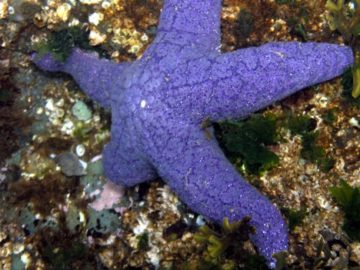
It became apparent very shortly that this was not an isolated instance of one sick animal but rather the beginning of a gruesome epidemic that within a couple of years would leave shallow seabed areas from Alaska to northern Mexico littered with disintegrating corpses of more than twenty sea star species. Although some form of sea star wasting disease had been observed periodically for several decades, its earlier impact had been minimal by comparison with the current outbreak.
The population of the hardest-hit sea star species, the sunflower sea star, collapsed from an estimated five billion plus individuals to a scattered few, to the point where the species appeared to have been extirpated from southern parts of its range in Mexico and California. One of the most common sea stars a decade ago, the sunflower sea star is now listed as critically endangered (the closest designation to extinction) on the International Union for Conservation of Nature’s (IUCN’s) Red List of Threatened Species. Status reports are being prepared for potential protection of Pycnopodia under the Endangered Species Acts of both the United States and Canada.
Defining the cause of the outbreak remains a challenging exercise. The syndrome was initially thought to have been triggered by an unknown virus. “Myriad” is an apt descriptor of the variety of marine viruses, given that there are estimated to exist ten viruses for every bacterium on the planet. University of British Columbia microbiologist Curtis Suttle has compared the number of viruses in the oceans to the number of stars in the universe, suggesting that viruses outnumber stars by a factor of ten million. Translating that to a more conceivable scale, it has been estimated that more than 700 million viruses, mainly of marine origin, are deposited every day from Earth’s atmosphere onto every square meter of the planet’s surface. A later theory suggested that the cause of the wasting syndrome might not be a virus but rather a bacterial infection resulting in reduction of oxygen available to the sea star, essentially causing it to suffocate. The definitive cause still remains uncertain.
As the outbreak continued, it became apparent that the spread of sea star wasting disease was following an unusual course, patchy in nature, infecting groups of sea stars in one location and then leapfrogging an adjacent area to appear in a new location separated from the first—rather like a wildfire leaping among stands of trees, leaving healthy individuals standing between outbreaks of fire, explains University of British Columbia zoologist Dr. Chris Harley.
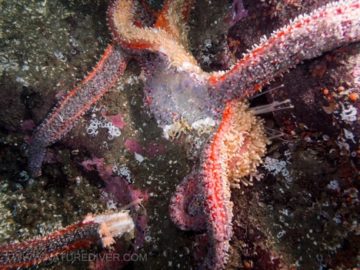
Currently, a team including researchers from the Hakai Institute, the University of British Columbia, the Friday Harbor Laboratories of the University of Washington, and the Nature Conservancy are collaborating to identify the causative agent of sea star wasting syndrome. “To do this,” explains Hakai Institute scientist Dr. Alyssa Gehman, “we run controlled exposure trials to demonstrate the ability of a putative pathogen to be transmitted from a sick star to a healthy star. From those experiments we are using genomic techniques to identify candidate pathogens. These are classic epidemiological techniques that you would use for any animal-pathogen detection. What makes working with sea stars tricky is that we are just at the beginning of learning what the ‘normal’ microbial and viral communities are that are associated with these stars. When you don’t know what is normal, it makes it much more difficult to detect something new or novel.”
Though the precise cause of sea star wasting syndrome remains to be identified, what has become clear is that unusually warm ocean temperatures both exacerbate and accelerate the disease trajectory—a fact that may explain why the disease has been so much more devastating in the southern part of the range of sunflower sea stars (Mexico and California) than in the north (British Columbia and Alaska). The beginning of the epidemic coincided fairly closely with the appearance in late 2013 of the extreme North Pacific marine heatwave that came to be known as “The Blob” and persisted more than two years, by the end of which time sunflower sea stars appeared to have been extirpated from the southern part of their range and greatly diminished in the northern part. Another of the many unknowns regarding the future prospects of sea stars is the extent to which ocean warming, periodic and local or permanent and widespread, will pose a threat to these and other marine species that have evolved to tolerate primarily moderate temperatures. One such species is kelp, both giant and bull.
The Original Keystone Species: Pisaster Ochraceus (Ochre Sea Star)
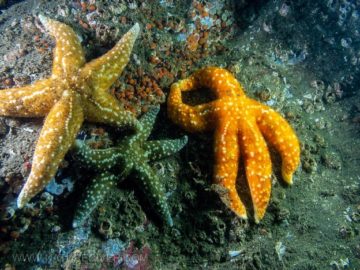
Almost fifty years before the MARINe researchers discovered diseased ochre sea stars on the Washington coast, ecologist Robert Paine conducted a 1966 experiment, also involving ochre stars, on the same Olympic National Park coast. The experiment involved removing all ochre sea stars from some tidal pools while leaving others in their natural state with the ochre sea star intact. One purpose of the experiment was to determine how the removal of the top predator (the ochre sea star) would affect the diversity of species in the contained ecosystem constituted by the tidal pool. The ochre sea stars’ diet consisted primarily of molluscs such as barnacles and mussels.
The results of Paine’s experiment were somewhat counterintuitive. Species diversity was much higher when the ochre sea stars were present than when they were removed. In Pisaster’s absence, acorn barnacles (Balanus glandula), freed from predation, crowded out most other species by rapidly using up the available space. Later, California mussels (Mytilus californiensis) in turn overran the barnacles. Algae was virtually eliminated from the pools, the only remaining remnants growing on the mussels. In short, a wide range of species was affected whether or not they were preyed upon directly by the sea star, and species diversity was greatly diminished by the removal of a single dominant species. By selectively feeding on barnacles and mussels and thus containing their spread, the ochre sea star ensured a healthy proliferation of species at lower trophic levels.
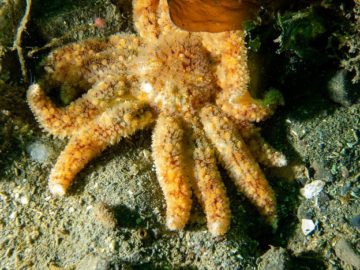
Paine’s findings inspired him to coin the term “keystone” to describe a predator that has a such a large effect on its natural environment relative to its abundance that its removal may result in ecosystem collapse. It’s an apt metaphor. The keystone is the wedge-shaped stone at the apex of an arch that locks all the other stones into place. Remove the keystone, and the other stones are likely to collapse in a cascading sequence. Disrupt the natural predator-prey balance, and the effects spread throughout the ecosystem, affecting virtually every species. Prey creatures, freed from a predator-prey relationship that may have evolved over hundreds of thousands of years or more, may multiply quickly to such a degree that their own natural prey cannot recover from the pressure, and that collapse leads to other collapses in turn.
“Keystone species” soon became a standard phrase in ecological parlance to describe any species with an influence on its environment disproportionate to its numbers—a definition far broader than Dr. Paine’s intended meaning of top predator. It has been subsequently used to describe species as diverse as wolves and beavers and bison and krill and cactus.
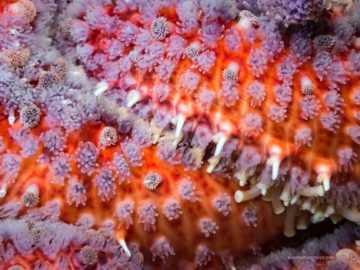
Another sea star that clearly qualifies as a keystone species in the sense intended by Robert Paine is the sunflower sea star (Pycnopodia helianthoides). Reaching up to a meter in diameter and growing between fifteen and twenty-four arms (though juveniles start out with five), the sunflower sea star is not only one of the largest sea stars on the planet but also one of the fastest, hustling along the ocean floor at speeds of up to 200 feet an hour on its several thousand tube feet. The diet of the sunflower sea star differs from that of the ochre sea star in that it includes a significant component of sea urchins—over 90 per cent in the case of some individuals. And it is this preponderance of sea urchins in the sunflower sea star diet that lends a particular importance to Pycnopodia’s role on the North Pacific coast as a species whose presence ensures ecosystem stability.
Urchins on the Rampage
Though the ultimate cause of sea star wasting disease remains in doubt, its impacts are all too evident, not only for the sea stars themselves but also for their prey and the entirety of the ecosystem they once inhabited.

Sea stars and sea urchins are kissing cousins in that both are echinoderms, their most common feature being radial symmetry—usually five-pointed with the notable exception of the sunflower sea star, which begins life with five arms as a juvenile before growing as many nineteen more. What particularly distinguishes the sea urchin from the sea star is the mass of moveable spines that help defend it from predators, move food towards its mouth and, incidentally, inspired its name because of its supposed similarity to a hedgehog, called “urchin” in Middle English.
A sea urchin familiar to young beachcombers everywhere is the sand dollar, the skeleton of which features a distinctive petal-like pattern and is frequently washed by the tide onto sandy beaches. Like other sea urchins, sand dollars have protective spines, though theirs are so small as to be virtually invisible when the creature is alive. The same can’t be said for the red sea urchin (Mesocentrotus franciscanus), the spines of which may be as long (up to three inches) as the test (skeleton) of the sand dollar is wide. The considerably smaller purple sea urchin (Strongylocentrotus purpuratus) and green sea urchin (Strongylocentrotus droebachiensis) frequently occupy the same areas of seabed as the red sea urchin. And all of them have a fondness for kelp.
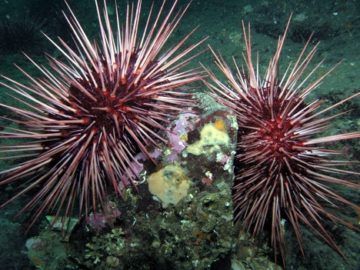
Sea urchin spines provide little protection against a massive sunflower sea star in search of a meal. Nor do they create much defence against a sea otter on the hunt for a taste of uni (sea urchin gonads, a sushi favorite). Sunflower sea stars and sea otters are a thoroughly effective natural partnership for keeping sea urchin population in check. Sea otters are another classic keystone species of the type described by Robert Paine, and their extirpation from the North Pacific coast south of Alaska during the eighteenth and nineteenth century fur trade resulted in the widespread disappearance of kelp forests as a result of exploding sea urchin populations. Although sea otter populations have been making a comeback in recent years in British Columbia, Washington and California, they are still at only a fraction of their historic levels. In essence, the sea urchin’s other primary predator, the sunflower star, took up the slack in keeping urchin populations under control and enabling kelp forests to remain healthy following the removal of the sea otter from the northeast Pacific.

Kelp forests along the California coast have been called “the sequoias of the sea”. Along more northerly parts of the Pacific coast, from Washington to Alaska, they’ve been described as “the rainforests of the ocean”. The analogies suggest not only the immensity of kelp—a kelp stalk can grow more than 150 feet in length and add up to two feet a day in ideal conditions—but also the value of kelp to marine biodiversity. Like a rainforest, a kelp forest provides protective cover and nutrition for a wide variety of species in addition to sequestering carbon, and yet the comparison with a forest on land doesn’t really to justice to its overall significance. In addition to its modern commercial uses (food, medicines, fertilizers and many more), kelp is an important resource to indigenous communities, not least because of the bountiful harvests of herring spawn deposited on kelp fronds in spring.
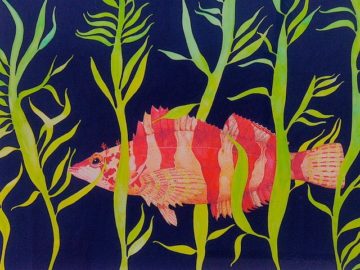
By intercepting ocean swells, kelp forests provide a mitigating effect against shoreline erosion in addition to sheltering inshore communities of marine life. And by muffling the penetrating and far-reaching noise of ship traffic, kelp forests may play an important role in protecting the ability of marine species (marine mammals and fish alike) to hear and communicate. While kelp forests may be largely out of sight and out of mind for most humans, they are without question one of the more important ecosystems on the planet.
The combined effects of ocean warming and predation by sea urchins during the past decade has been devastating for kelp forests along the west coast of North America. Kelp forests are widespread along polar and temperate coasts around the world, but they don’t do well in warmer water and start to die when temperatures at the surface of the ocean reach 20 or 22 degrees Centigrade. The Blob, which heated up the northeast Pacific from 2014 to 2016, resulted in temperatures higher than that in inshore waters. A 2022 study of giant kelp and bull kelp forests that had been stable for at least four decades in Barkley Sound on western Vancouver Island found that, since the 2013 Blob, 40 percent of the kelp beds had disappeared and had not grown back.

In 2021, satellite imagery showed that 95 percent of California’s kelp forests had been destroyed and replaced by carpets of sea urchin barrens. “Sea urchin barrens” are areas of seabed essentially devoid of life other than masses of urchins (typically purple) in a zombie-like state after consuming every piece of kelp or other algae in the area. Following the collapse of the sunflower sea star population, sea urchin populations exploded up and down the coast (by as much as 10,000 per cent, at one reef tested in Oregon). In times when their populations were kept in check by natural predators, sea urchins tended to primarily inhabit tidal pools and forage on kelp litter. Those times are no more. When armies of sea urchins are so large that they consume entire kelps—root, stipe (stalk), blades and all—the forest may be doomed as surely as a stand of trees consumed by wildfire.
When the forest has been eaten to nothing, purple sea urchins, which can survive long periods without food notwithstanding their prodigious appetite for kelp, simply litter the seabed in a riot of sinister color, and wait for whatever comes their way, rousing themselves to devour any kelp that begins to re-establish its presence. Sadly, it’s a scenario repeated with increasing frequency in the inland waters of the Pacific coast. Meanwhile, marine heatwaves are occurring with increasing intensity and frequency.
Hopeful Signs, Meaningful Actions
Recently there have been small signs of recovery among sunflower sea star populations close to Alaska, as well as more significant signs among ochre sea star populations in the northern part of their range. The fact that the impact of the disease on sea stars has not been uniform throughout their range, and that patches of their populations have been unaffected for unclear reasons, suggests potential opportunities for facilitating recovery, little by little.
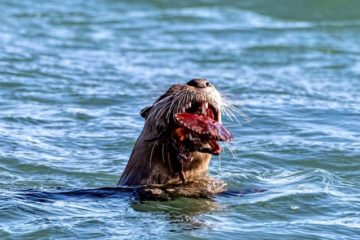
Much work remains to be done in defining those opportunities. First, the collaborative research referenced above (among the Hakai Institute, University of British Columbia, University of Washington and the Nature Conservancy) needs to complete its work of isolating the causative agent of sea star wasting. That work includes identifying areas where sea stars survive, what may contribute to their survival in those locations, and what genetic characteristics may contribute to their survival. In related work, the Nature Conservancy has published a comprehensive Roadmap to Recovery for the Sunflower Sea Star.
Elsewhere, as reported by the Kelp Restoration Project,
• The Council of the Haida Nation has worked with Canadian federal government agencies and sea urchin fishers to improve kelp habitat through commercial fishing of sea urchins, traditional fishing, and cracking of red urchins by divers.
• At Mendocino, California, local communities and state agencies have cooperated to establish a network of bull kelp refugia to create habitat, preserve genetic diversity, and maintain spore sources to facilitate broader bull kelp recovery.
• In the Los Angeles area, the Palos Verdes Kelp Restoration Project saw a collaboration among various organizations to monitor and cull purple sea urchin barrens to enable the recovery of giant kelp.
Solutions to an ecological problem of this magnitude and over such a wide geographical range inevitably depend in large part on citizen volunteers reporting their observations. One way of doing so is through the iNaturalist app, which enables members to identify sea stars by photo and to share that information with organizations like Primary Responders in Marine Emergent Disease Network (PRIMED) and seastarwasting.org, which continues to document the distribution and health of sea stars along the west coast of North America, assess the impact of sea star wasting disease and the outlook for recovery, and assess how the decline of sea star populations affects other species.
In addition to recording observations, concerned citizens can support the work of organizations closely involved in determining the cause of and opportunities for recovery from sea star wasting syndrome. These include:
• The Hakai Institute
• Monterey Bay Aquarium Research Institute
• The Nature Conservancy
• Friday Harbor Laboratories.
Alternatively or in addition, you might take whatever steps you deem worthwhile to curb emissions of carbon dioxide and other greenhouse gases currently warming and being absorbed in considerable quantities by the oceans. There is little doubt that, in the absence of human-caused climate change, sea star wasting disease would be far more manageable and less widespread than it is, and the temperature-sensitive kelp forests would be far less at risk than they are, with concomitant benefits for all the marine species that depend on them. It’s now more than half a century since the immortal words of Pogo were featured on a poster for the very first Earth Day: “We have met the enemy and he is us.” Plus ça change.
The old adage, “Think globally, act locally” seems as apt for this important issue as for any other. So download the iNaturalist app, wander down to the seashore (if you have one handy), and keep your eyes peeled for anything with five arms or, even better, between fifteen and twenty-four.
§ § §
Thanks to Dr. Alyssa Gehman, marine disease ecologist at the Hakai Institute and adjunct professor at the UBC Institute of Oceans and Fisheries and to Dr. Christopher Harley of UBC’s Department of Zoology for information and advice during the preparation of this article. Susan Taylor of Blood Star Gallery generously permitted the use of two of her paintings to illustrate this article, and Derek Holzapfel kindly permitted me to use a selection of his photographs from his website naturediver.com, which meticulously documents marine life in the Salish Sea. Myles Clarke (Instagram @emylesclarke) kindly provided the photo of the river otter preparing for a crab feast.
